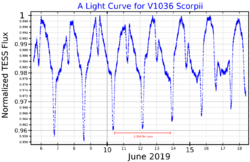Astronomy:HD 159176
| Observation data Equinox J2000.0]] (ICRS) | |
|---|---|
| Constellation | Scorpius |
| Right ascension | 17h 34m 42.49213s[2] |
| Declination | −32° 34′ 53.9955″[2] |
| Apparent magnitude (V) | 5.71 - 5.79[3] |
| Characteristics | |
| Spectral type | O6.5V + O7V[4] |
| Variable type | Rotating ellipsoidal[3] |
| Astrometry | |
| Proper motion (μ) | RA: 2.621±0.083[2] mas/yr Dec.: −0.798±0.058[2] mas/yr |
| Parallax (π) | 1.1666 ± 0.0707[2] mas |
| Distance | 2,800 ± 200 ly (860 ± 50 pc) |
| Orbit[5] | |
| Primary | Primary |
| Companion | Secondary |
| Period (P) | 3.366767 d |
| Eccentricity (e) | 0.0 |
| Periastron epoch (T) | 2448885.420±0.003 |
| Semi-amplitude (K1) (primary) | 215.7±1.4 km/s |
| Semi-amplitude (K2) (secondary) | 218.1±1.5 km/s |
| Details | |
| Primary | |
| Mass | 46.4+14.3 −9.5[4] M☉ |
| Luminosity | 5.50±0.10[4] L☉ |
| Temperature | 38,000[4] K |
| Secondary | |
| Mass | 44.2+13.6 −9.1[4] M☉ |
| Luminosity | 5.41±0.10[4] L☉ |
| Temperature | 36,750[4] K |
| Other designations | |
| Database references | |
| SIMBAD | data |
HD 159176, also known as Boss 4444 and V1036 Scorpii, is a variable star about 2,800 light years from the Earth, in the constellation Scorpius.[2] It is a 5th magnitude star, so it should be visible to the naked eye of an observer far from city lights. HD 159176 is the brightest star in the young open cluster NGC 6383.[4] It is a binary star composed of two nearly identical O stars in a circular orbit.[7]
In 1930, Robert Trumpler discovered that HD 159176 is a spectroscopic binary. He noted that the two stars have very nearly the same brightness and spectral type. In addition, he was observing at the Lick Observatory, so the far southern declination of the star meant it could only be observed near transit. Those three things together prevented him from unambiguously measuring the orbital period.[8] The first full set of orbital elements, including the 3.3664±0.0003 day period, was derived by Peter Conti et al. in 1975.[9] Also in 1975, photometric observations by J. C. Thomas showed that HD 159176 is a rotating ellipsoidal variable.[10][11] The star's spectra exhibit the Struve–Sahade effect.[4] HD 159176 was given the variable star designation V1036 Scorpii, in 1997.[12]
Although HD 159176 was long considered to be a non-eclipsing binary,[4][7][13][14] data from the Transiting Exoplanet Survey Satellite does show eclipses.[15]
HD 159176 has an X-ray luminosity far higher than would be expected from two isolated O stars. The excess X-rays may arise from interacting stellar winds.[7]
References
- ↑ "MAST: Barbara A. Mikulski Archive for Space Telescopes". Space Telescope Science Institute. https://mast.stsci.edu/portal/Mashup/Clients/Mast/Portal.html.
- ↑ 2.0 2.1 2.2 2.3 2.4 2.5 Vallenari, A. et al. (2022). "Gaia Data Release 3. Summary of the content and survey properties". Astronomy & Astrophysics. doi:10.1051/0004-6361/202243940 Gaia DR3 record for this source at VizieR.
- ↑ 3.0 3.1 Samus', N. N.; Kazarovets, E. V.; Durlevich, O. V.; Kireeva, N. N.; Pastukhova, E. N. (2017). "General catalogue of variable stars: Version GCVS 5.1". Astronomy Reports 61 (1): 80. doi:10.1134/S1063772917010085. Bibcode: 2017ARep...61...80S.
- ↑ 4.0 4.1 4.2 4.3 4.4 4.5 4.6 4.7 4.8 4.9 Penny, Laura R.; Epps, Jacob G.; Snyder, Joseph D. (December 2016). "Tomographic Separation of Composite Spectra. XII. The Physical Properties and Spectral Phase Variability of the Massive Close Binary HD 159176". The Astrophysical Journal 832 (2): 211. doi:10.3847/0004-637X/832/2/211. Bibcode: 2016ApJ...832..211P.
- ↑ Stickland, D. J.; Koch, R. H.; Pachoulakis, I.; Pfeiffer, R. J. (August 1993). "Spectroscopic binary orbits from ultraviolet radial velocities. Paper 12: HD 159176". The Observatory 113: 204–209. Bibcode: 1993Obs...113..204S.
- ↑ "HD 159176 -- Spectroscopic Binary". SIMBAD. Centre de données astronomiques de Strasbourg. http://simbad.u-strasbg.fr/simbad/sim-basic?Ident=HD+159176+--+Spectroscopic+Binary.
- ↑ 7.0 7.1 7.2 De Becker, M.; Rauw, G.; Pittard, J. M.; Antokhin, I. I.; Stevens, I. R.; Gosset, E.; Owocki, S. P. (March 2004). "An XMM-Newton observation of the massive binary HD 159176". Astronomy and Astrophysics 416: 221–233. doi:10.1051/0004-6361:20031710. Bibcode: 2004A&A...416..221D.
- ↑ Trumpler, Robert J. (December 1930). "A New Double-Line Spectroscopic Binary". Publications of the Astronomical Society of the Pacific 42 (250): 342–346. doi:10.1086/124068. Bibcode: 1930PASP...42..342T.
- ↑ Conti, P. S.; Cowley, A. P.; Johnson, G. B. (April 1975). "The double-line spectroscopic binary HD 159176". Publications of the Astronomical Society of the Pacific 87: 327–332. doi:10.1086/129763. Bibcode: 1975PASP...87..327C.
- ↑ Thomas, J. C. (September 1975). "A Photometric Investigation of the Double-Lined O-Star Binary, HD 159176". Bulletin of the American Astronomical Society 7: 533. Bibcode: 1975BAAS....7..533T.
- ↑ Thomas, J. C.; Pachoulakis, I. (November 1994). "V and UV Photometry of HD 159176". Information Bulletin on Variable Stars 4115 (1): 1. Bibcode: 1994IBVS.4115....1T.
- ↑ Kazarovets, E. V.; Samus, N. N. (April 1997). "The 73rd Name-List of Variable Stars". Information Bulletin on Variable Stars 4471: 1. Bibcode: 1997IBVS.4471....1K. https://ibvs.konkoly.hu/pub/ibvs/4401/4471.pdf. Retrieved 29 January 2023.
- ↑ Pfeiffer, R. J.; Pachoulakis, I.; Koch, R. H.; Stickland, D. J. (October 1997). "The winds of hot close binaries. Paper 3: HD 159176". The Observatory 117: 301–309. Bibcode: 1997Obs...117..301P.
- ↑ "V1036 Sco". AAVSO. https://www.aavso.org/vsx/index.php?view=detail.top&oid=33852.
- ↑ Burssens, S.; Simón-Díaz, S.; Bowman, D. M.; Holgado, G.; Michielsen, M.; de Burgos, A.; Castro, N.; Barbá, R. H. et al. (July 2020). "Variability of OB stars from TESS southern Sectors 1-13 and high-resolution IACOB and OWN spectroscopy". Astronomy and Astrophysics 639: A81. doi:10.1051/0004-6361/202037700. Bibcode: 2020A&A...639A..81B.
 |


